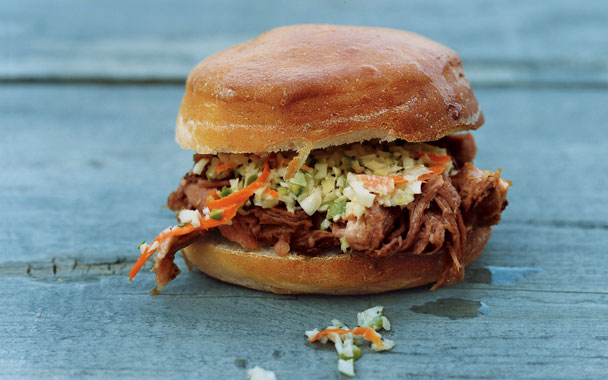A lot of love went into the pulled pork sandwiches on the Eastern North Carolina menu. The initial challenge of adapting this style of barbecue for the home kitchen is that in North Carolina, they cook over wood, in a pit, and they most often cook the whole animal, which is enormous—and it takes all day. I wanted to see what I could do in the oven, for those people who don’t have pits or smokers (or at least don’t have any interest in standing over them all day, adding coals to the fire).
With a whole pig, you don’t even need to sprinkle it with salt and pepper. The slow-roasting renders the fat through the meat, and because you chop the whole thing up when it’s done, the meat from all the different parts—with all their varying fat contents—mixes together and becomes very succulent. Instead, I decided to roast a shoulder, a nice, fatty cut that would stay moist in the oven. Typically, the richness is cut with a “mop” sauce, which is just cider vinegar, hot pepper, black pepper, a little salt, and a little sugar. You pour it directly on your sandwich, and you also moisten the meat with it while chopping it. I made the mop sauce ahead of time and poured some in the roasting pan, creating a sort of braising liquid.
I tried supermarket pork several times, which was very tasty, but I was curious about how differently the recipe would turn out with heritage pork. We ordered two shoulders from the South Carolina farm Caw Caw Creek, which raises Ossabaw Island pigs. The heritage pork had a lot of fat and much more flavor. We all loved it. Then, since the recipe was all but perfected, I took the second shoulder home, just to try it out in a different oven. Well, I was very klutzy that day. I opened up the oven to check on the roast, and I must have given the rack a jerk as I slid it back in, since about three quarts of hot fat flew out, all over my stove and onto the floor. It migrated into the oven door, and it took many, many cleanings—including taking the oven door off the hinges—to get rid of all traces of it. For a few days, we kept finding more patches of grease, so we would clean again; and then we’d find some more. Though I think the heritage pork is absolutely worth it, the lesson is to pay attention when you’re moving that pan around. It seems there are good reasons why this kind of cooking is usually done out of doors.
Whether you decide to slow-cook the pork indoors or out, the results will be equally delicious.



 Pinterest
Pinterest


